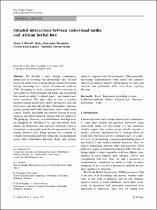JavaScript is disabled for your browser. Some features of this site may not work without it.
- ResearchSpace
- →
- Research Publications/Outputs
- →
- Journal Articles
- →
- View Item
| dc.contributor.author |
Bidwell, NJ

|
|
| dc.contributor.author |
Winschiers-Theophilus, H

|
|
| dc.contributor.author |
Koch-Kapuire, G

|
|
| dc.contributor.author |
Chivuno-Kuria, S

|
|
| dc.date.accessioned | 2011-12-14T11:16:02Z | |
| dc.date.available | 2011-12-14T11:16:02Z | |
| dc.date.issued | 2011 | |
| dc.identifier.citation | Bidwell, NJ, Winschiers-Theophilus, H et al. 2011. Situated interactions between audiovisual media and African herbal lore. Personal and Ubiquitous Computing, Vol 15(6), pp 609–627 | en_US |
| dc.identifier.issn | 1617-4909 | |
| dc.identifier.uri | http://meraka.academia.edu/NicolaJBidwell/Papers/771873/Situated_interactions_between_audiovisual_media_and_African_herbal_lore | |
| dc.identifier.uri | http://hdl.handle.net/10204/5416 | |
| dc.description | Copyright: 2011 Springer Verlag (Germany). This is the Post Print version of the paper. The definitive version is published in Personal and Ubiquitous Computing, Vol 15(6), pp 609–627 | en_US |
| dc.description.abstract | The authors describe a rural African community’s interactions in recording and interpreting video on herb lore in our endeavours to design digital systems that extend sharing knowledge in a system of traditional medicine (TM). Designing for such a system involves reflecting on own narratives about medicine and media and recognising that narratives reflect ‘‘cultural logics’’ and media transforms narratives. The authors used video as sites to explore meaning-making in herb lore; anchor our dialogic with, and about users; and, elicit design ideas. Participants’ prioritise speech, gesture and bodily interaction, above other visual context. Further, recordings can embody nuances in social relations and depict temporal patterns that are integral to TM pedagogy. However, such embodiments and depictions are disrupted by affordances of, and associations with, media; our abstraction; and, non-local ontologies (such as chronologic or geographic point-based representation). The authors' insights produce new design patterns by orienting us towards representing herb lore within the social-relational spaces that contextualise knowing, doing and moving, linked to corporeal and felt-experiences. More generally, uncovering transformations when media and narrative interact can improve analysis and designing for logics and literacies that profoundly differ from those typifying ubicomp. | en_US |
| dc.language.iso | en | en_US |
| dc.publisher | Springer verlag (Germany) | en_US |
| dc.relation.ispartofseries | Workflow request;6924 | |
| dc.subject | Narratives | en_US |
| dc.subject | Rural African communities | en_US |
| dc.subject | Cultural logics | en_US |
| dc.subject | Traditional medicines | en_US |
| dc.subject | Herbal lore | en_US |
| dc.subject | Audiovisual media | en_US |
| dc.subject | African herbal lore | en_US |
| dc.title | Situated interactions between audiovisual media and African herbal lore | en_US |
| dc.type | Article | en_US |
| dc.identifier.apacitation | Bidwell, N., Winschiers-Theophilus, H., Koch-Kapuire, G., & Chivuno-Kuria, S. (2011). Situated interactions between audiovisual media and African herbal lore. http://hdl.handle.net/10204/5416 | en_ZA |
| dc.identifier.chicagocitation | Bidwell, NJ, H Winschiers-Theophilus, G Koch-Kapuire, and S Chivuno-Kuria "Situated interactions between audiovisual media and African herbal lore." (2011) http://hdl.handle.net/10204/5416 | en_ZA |
| dc.identifier.vancouvercitation | Bidwell N, Winschiers-Theophilus H, Koch-Kapuire G, Chivuno-Kuria S. Situated interactions between audiovisual media and African herbal lore. 2011; http://hdl.handle.net/10204/5416. | en_ZA |
| dc.identifier.ris | TY - Article AU - Bidwell, NJ AU - Winschiers-Theophilus, H AU - Koch-Kapuire, G AU - Chivuno-Kuria, S AB - The authors describe a rural African community’s interactions in recording and interpreting video on herb lore in our endeavours to design digital systems that extend sharing knowledge in a system of traditional medicine (TM). Designing for such a system involves reflecting on own narratives about medicine and media and recognising that narratives reflect ‘‘cultural logics’’ and media transforms narratives. The authors used video as sites to explore meaning-making in herb lore; anchor our dialogic with, and about users; and, elicit design ideas. Participants’ prioritise speech, gesture and bodily interaction, above other visual context. Further, recordings can embody nuances in social relations and depict temporal patterns that are integral to TM pedagogy. However, such embodiments and depictions are disrupted by affordances of, and associations with, media; our abstraction; and, non-local ontologies (such as chronologic or geographic point-based representation). The authors' insights produce new design patterns by orienting us towards representing herb lore within the social-relational spaces that contextualise knowing, doing and moving, linked to corporeal and felt-experiences. More generally, uncovering transformations when media and narrative interact can improve analysis and designing for logics and literacies that profoundly differ from those typifying ubicomp. DA - 2011 DB - ResearchSpace DP - CSIR KW - Narratives KW - Rural African communities KW - Cultural logics KW - Traditional medicines KW - Herbal lore KW - Audiovisual media KW - African herbal lore LK - https://researchspace.csir.co.za PY - 2011 SM - 1617-4909 T1 - Situated interactions between audiovisual media and African herbal lore TI - Situated interactions between audiovisual media and African herbal lore UR - http://hdl.handle.net/10204/5416 ER - | en_ZA |






